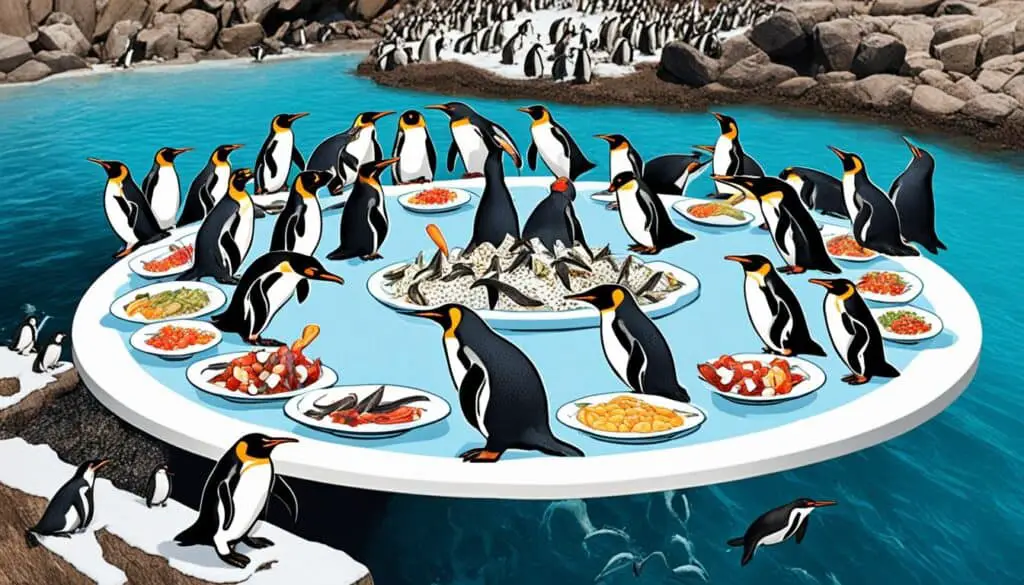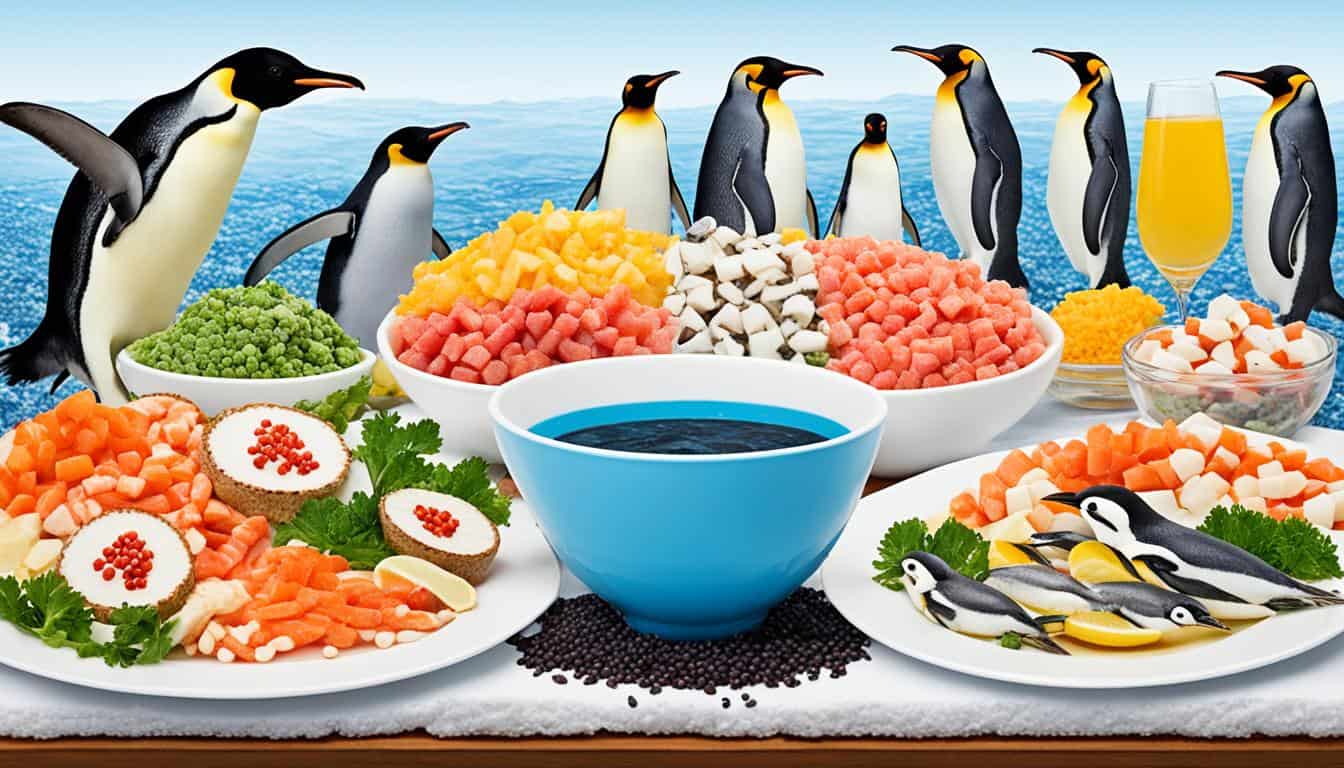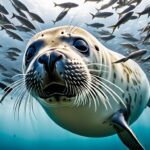Learning about the penguin diet helps us understand these amazing birds and their place in the ocean. You might ask, what do penguins eat? Different penguin species eat various foods, which affects their penguin food habits and penguin nutrition. Knowing what they eat is key to helping us protect their homes and the balance of nature. Let’s explore the main foods that feed penguins and see how their eating habits help them survive and keep their ecosystems healthy.
Understanding the Penguin Diet
The penguin diet shows us how these flightless birds eat. They mainly eat krill, squid, and different fish. Each penguin type has its own way of eating, based on its body and where it lives. Smaller penguins like small fish and krill, while bigger ones eat larger fish or squid.
Penguins have found ways to eat without fighting over food. This lets different kinds live in the same place without fighting over food. This is key to their survival, especially in tough places where food is scarce.
Things like the seasons change what penguins can eat. These changes affect where they find food and how they move. When they’re raising their young, penguins might eat more to feed their babies.
To wrap up, let’s look at the variety in what penguins eat and why it’s important for them. Here’s a table that shows what different penguins eat and how they adapt:
| Penguin Species | Primary Food Sources | Adaptations |
|---|---|---|
| Emperor Penguin | Fish, squid, krill | Deep diving capacity |
| Adelie Penguin | Krill, small fish | Agile swimming |
| Chinstrap Penguin | Krill, fish | Strong foraging skills |
| Gentoo Penguin | Small fish, squid | Speedy swimmer |
The Primary Foods in a Penguin’s Diet
Learning about penguin food habits shows us what they like to eat. Penguins eat mainly krill, squid, and fish. These foods are key for their energy and health.
Krill is a big part of a penguin’s diet, especially for the Adélie penguin. These small crustaceans are found in cold waters and are full of energy. Adélie penguins eat a lot of krill during certain times, showing their penguin meal preferences.
Squid is also important for penguins. Many penguin species rely on squid for protein, which is crucial for growth and staying healthy. Their hunting skills let them catch squid efficiently, helping them survive in tough places.
Fish completes a penguin’s diet. Different penguins hunt various fish based on where they live and what’s available. This shows how penguins adapt their food choices to live in different environments.
| Food Type | Nutritional Value | Penguin Species Preferentially Consuming |
|---|---|---|
| Krill | High in protein and omega-3 fatty acids | Adélie, Gentoo |
| Squid | Rich in proteins and low in fat | Emperor, Macaroni |
| Fish | Source of fats and vitamins | Chinstrap, King |
What do penguins eat?
Penguins have unique food habits suited to their environments. Their penguin diet is key to their survival. Krill is a big part of the diet for smaller penguins like the Adélie and chinstrap penguins.
The Role of Krill in Their Diet
Krill is a main food for many penguins because it’s easy to find in their homes. It’s full of nutrients that help penguins grow and stay healthy. When krill is plentiful, penguins eat a lot of it. But when there’s less, they eat other sea creatures too.
Prey Preferences by Penguin Species
Each penguin type likes different foods, based on where they live and what’s available. Here’s what some common penguins eat:
| Penguin Species | Main Prey | Dietary Characteristics |
|---|---|---|
| Adélie Penguin | Krill | Primarily feeds on krill; significant seasonal variations |
| Chinstrap Penguin | Krill, small fish | Varies diet based on krill abundance; consumes fish during shortages |
| Emperor Penguin | Fish, squid, krill | Diverse diet; relies on larger prey like fish and squid |
| King Penguin | Fish, squid | Predominantly focuses on fish; limited krill consumption |

Feeding Habits of Different Penguin Species
Various penguin species have adapted to their environments in amazing ways. For example, king and emperor penguins travel long distances across icy waters to find food. This is crucial for their survival, especially during breeding season when food is scarce. They dive deep to catch different types of prey, making sure they get a balanced diet.
On the other hand, smaller penguins like the little blue penguin forage near their nests. They take advantage of the food that’s easily available to them. This shows how important location is for their diet. Their feeding habits also depend on their size and the challenges they face from climate change and predators.
Understanding penguin feeding habits helps us see how they adapt to different life stages. During molting and breeding, they need different amounts of food to stay healthy and energized. This shows how crucial it is for their survival in the tough Antarctic environment.
FAQ
What do penguins primarily eat?
Penguins mainly eat krill, squid, and fish. The food they eat changes with their species, where they live, and how they hunt.
How do penguin diets vary by species?
Each penguin type has its own favorite foods. This helps them avoid fighting over food. For instance, Adélie penguins love krill, while others might prefer fish or squid.
Why is krill important for penguins?
Krill is key for many penguins, especially the Adélie and chinstrap penguins. It gives them the nutrients and energy they need to survive. This is true during breeding and molting seasons.
How do environmental factors affect penguin diets?
Things like how much prey is around and the time of year change what penguins eat and how they hunt. These changes are vital for their survival in tough climates.
What are some common foraging techniques used by penguins?
Penguins use different ways to find food. Some dive deep for fish, while others catch krill and squid near the surface. They change their methods based on what’s available and their hunting style.
How much food do penguins need during different life stages?
Penguins need different amounts of food at different times of their lives. They eat more during breeding and molting to stay healthy and successful in raising their young.







